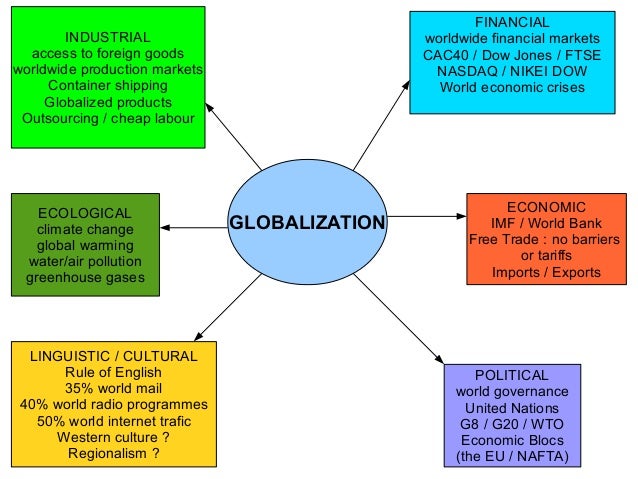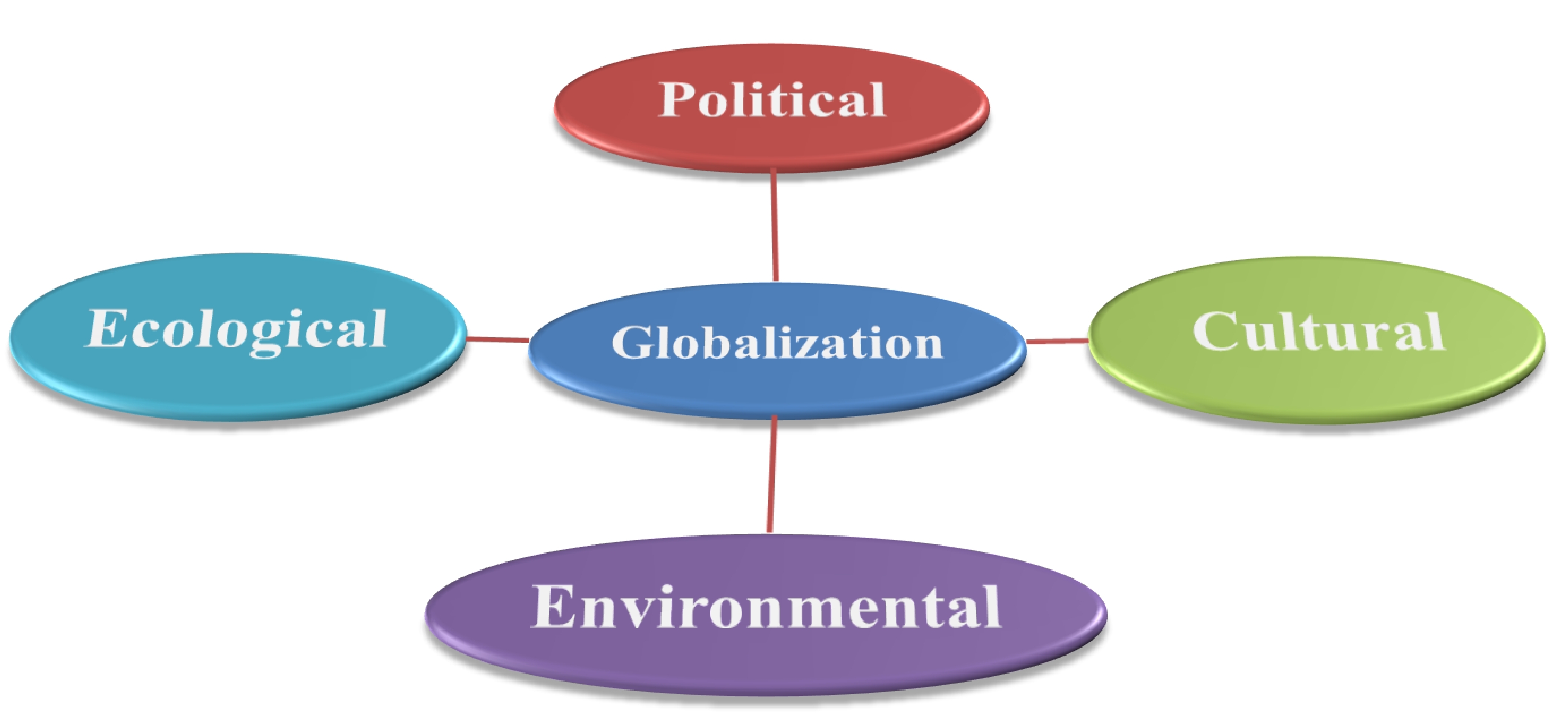Dimensions Of Globalization Pdf
This article provides information about the social dimension of globalisation:
It is strongly refuted that the current pace of globalisation reflects on the economic front only. The ramifications of globalisation process reflect directly in the social and cultural arena of human life as well. Consequently understanding social and cultural dimensions of the phenomenon of globalisation means is essential. The social dimension of globalisation means the impact of globalisation on the life and work of people, on their families and their societies.
The ecological dimension of globalization is the most crucial, and impacted by the other three dimensions. The increased demand for food due to population explosions has deforested large portions of the Amazon rainforest, and human-induced climate change has created the greenhouse effect, which has caused the oceans to warm, making large ice shelfs melt and. .globalization of culture leads to a homogenization of world culture and it largely represents the 'Americanization' of world cultures.Reasons for the prominent role of USA in cultural globalization:.The size of the U.S. Market With nearly 300 million consumers, the United States is one of the largest markets in the world. MODULE Structures of Globalization 3 The Global Economy Lesson Objectives: At the end of this lesson, you should be able to: 1. Define economic globalization 2. Identify the actors that facilitate economic globalization 3. Define the modern world system 4. Articulate a stance on global economic integration Definition of Terms Economic globalization is the expansion of national economies, the. Keywords: business types, globalization types, foreign trade theory. Introduction On the one hand, economic globalization is often viewed as an obscure process that appar-ently yields more profit for the companies, while increasing unemployment for the work-ing classes. On the other hand, globalization is hardly controllable, since it is not only a.
Image Courtesy : djcadteam9.files.wordpress.com/2012/01/globalisation.jpg
The liberalisation of the economy resulted in a general reduction in the role of the State in economic governance. The reduction in the government’s economic role reflected in a decline in the public spending. Total government expenditure in India in public spending increased at a per annum rate of 11.0% during the 1960s, 7.1 % in the 1970s, 6.46% in the 1980s, but it declined to a per annum rate of 4.7% in the 1990s. The consequence of the reduction in the role of the government and the public sector and its replacement with private sector means that the access of people to employment, capital and social services like education, housing and health services will be much less.
The structural adjustment policies of the national government involving the relinquishing of economic activities from the public sector into the hands of the private sector, i.e., the state moving away from economic planning and leaving economic decisions to the market, will result in the withdrawal of social protection to the public. Reducing social benefits in order to reduce payroll fringe costs to increase competitive ability leads to “social dumping” which means a process that lowers production costs through low wages and substandard social conditions.
Economic liberalisation and globalisation had a direct impact both on rural and urban poverty. The substantial changes the institutional arrangement for rural credit, a key factor in helping the poor to escape poverty, due to the reforms in the banking sector have gone against the interests of the rural poor. The unsustainable development practices also lead to the impoverishment of the poor. The decline in social sector expenditure or stagnation in social sector expenditure in proportion to GDP also went against the interests of the poor.
ADVERTISEMENTS:
In urban areas, the large scale private investment, both foreign and Indian, led to the acquisition of city lands which in turn affected the poor, mainly slum dwellers, hawkers, destitute, street dwellers as they were pushed out of the city to the peripheries which are marked by degeneration with low value employment and poor living conditions.
Sustainable development is defined as development that meets the needs of the present generation without compromising the ability of future generations to meet their own needs. Under this definition, development is not just limited to economic growth but is made to encompass environmental protection, and an’ equitable distribution of wealth and resources with the goal of improving and raising the standards and quality of living for everyone.
The development practices followed the world over during the globalisation era marked by a high level of market competitiveness often seemed to follow unsustainable development practices. Globalisation has a profound effect on all our cultures and on the ways we live our lives. It has affected what we eat and the way we prepare our food, what we wear and the materials from which our clothing is made, it has affected the music we hear, the books we read, even the language we used to communicate with others. Globalisation has made certain languages extinct (dead language) or dying, for example, Latin.
At the same time more people today are bilingual or multilingual than ever before. English, though in variant forms (e.g., British English, American English, Indian English) has become the lingua franca and the number of English speakers throughout the world is growing rapidly. The central problem of today’s global interactions is the tension between cultural homogenisation and cultural hetrogenisation.
Five Dimensions Of Globalization
While scholars like McLuhan talk about global integration and global village, which may result from the process of globalisation, and resulting cultural integration across borders, there have been apprehensions about cultural marginalisation or cultural exclusion as well. Global flows of goods, ideas and people and capital can seen as a threat to the national culture in many ways.
Dimensions Of Globalization Pdf Definition
Cultural change or cultural dynamics has always been a product of interaction with other cultures. Though individual cultures are capable of endogamous developments, cultural boundaries are quite often porous leading to the interpenetration of cultures. Cultural dynamism is the outcome of a process of mixing; borrowing and adapting cultural attributes and often the attributes that are borrowed and adopted come from cultures that are alien, distant and foreign.
Political Dimension Of Globalization
Historically cultural dynamism has been greatest where trade and exchange in general have been voluminous and frequent. National and regional cultures are invariably a product of assimilation of various elements from other cultures, of a synthesis of elements that is a product of cultural interpenetration. Seaports and river ports have historically been centres of cultures and civilisation. Today in the hi-tech communication era, in which ICTs made communication easier, faster and cheaper than in the past, more and more cultural interpenetration is taking place.

In other words, we can put it that the acceleration of globalisation hasten the pace of cultural change. Trade agreements have removed all obstacles and resistance to corporate invasion and control of human society. With liberalisation of telecommunications, corporate culture is set to rule the world. Today the whole world is wired and plugged into the same TV programmes, movies, news, music, life-styles and entertainment. Satellite cables, phones, Walkman, VCDs, DVDs and retail giants and other marvels and wonders of entertainment technology are creating the mass marketing of culture and expansion of consumer culture.

This may lead to a homogenised global culture. In the case of the media industry, the logic of profit and competition has driven media corporations to enlarge media and space markets, and to break down the old boundaries and frontiers of national communities. Globalisation also gives rise to active cultural campaigning to defend local identities. Nations reject global cultural integration and people remain loyal to local histories, identities and traditions.
For example, European countries have campaigned against the threat of Americanisation (standardisation) and have defended the diversity and difference of European cultures. It is also possible to have attempts within the country by certain sections of people who refuse to integrate or adopt alien cultures as well as conduct massive movements against this trend. For example Shiv Sena activists have been campaigning against Valentine’s Day celebrations in India.